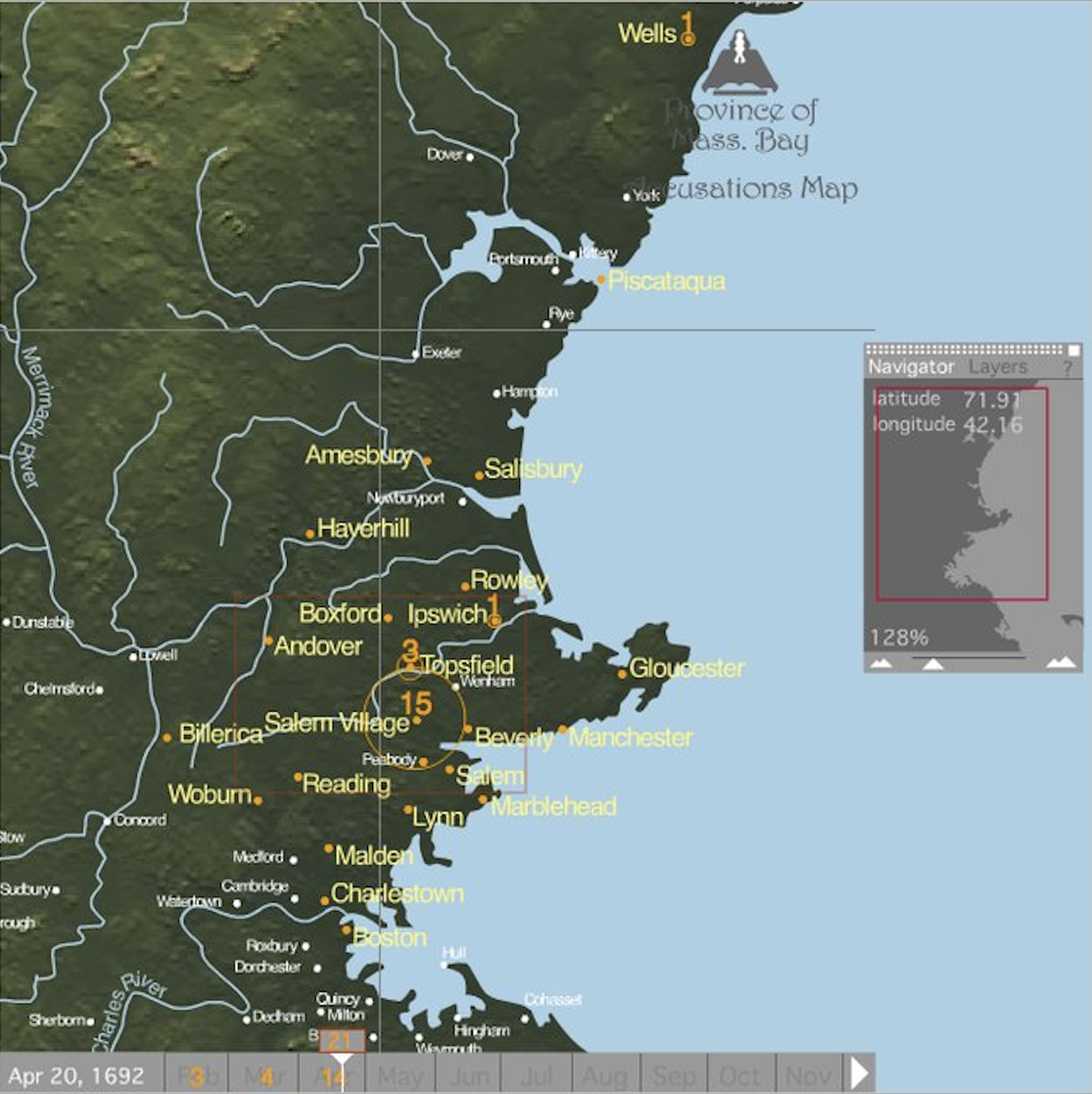Created by Cole Sherwin on Thu, 05/02/2024 - 10:39
Description:
The image above is a static map representing the locations of witchcraft accusations across Northeastern America. The map shows where accusations have spread to by April of 1692. This is represented by the orange markings on the map. Benjamin Ray, director of the Salem Witch Trials Documentary Archive at the University of Virginia, was the creator of the map. The purpose? Curiosity of the accelerated spread rate of witchcraft accusations. Ray noticed similarities between the accusations and the transmission of a disease. (“Examples of Spatial Humanities Projects”). The findings indicate that mass hysteria/chaos have similar traits to those of a disease. Thus, the reason behind the accelerated spread rate.
One of the most well-known cases of paranoia in United States history, the Salem Witch Trials. Throughout the course of history, there have been tales of the "supernatural" such as bigfoot, El Chupacabra, and other mysterious creatures; however, the only one that has been found is the "witch". In a small town in Salem, Massachusetts, widespread panic broke out after two young girls contracted a mysterious illness. After around of a month of this illness, their parents decided to take them to the local minister who deemed this was "witchcraft". Over the course of the next year, the girls and others in the surrounding community turned against each other in fear of being labeled a "witch". The punishment for this label? Death. However, if you admitted to practicing witchcraft, begged for forgiveness for your sins, and pointed out other fellow "witches", you could live. During the span of February 1962 - May 1963, over 200 people were accused of being witches and thirty were found guilty -- nineteen of which were executed by hanging. This map shows the localization of these of witchcraft accusations throughout 1962 (“Salem Witch Trials”). If you look closely, you can see a centralized area near the Salem Village. However, the paranoia began to spread to nearby towns and villages such as Topsfield and Ipswich were only a few witchcraft charges were made. These charges and accusations spread as far as Wells where 1 accusation was made. These accusations and charges were held up on the account of spectral evidence, which is evidence that cannot be seen. Thus, making these charges spread even faster. Soon these accusations began to turn into haste and tore the community apart. Eventually, Governor Phips’s wife was accused of being a witch. In what can be assumed as protecting his wife, Phips ruled that spectral evidence would not be able to stand alone in court. Thus, the accusations that were once spreading like wildfire, began dwindling down, until eventually, they came to a stop.
Thematically, the Salem Witch Trials connects to “The Birth-mark” by Nathaniel Hawthorne. Aylmer has a wife, Georgiana, who he recently notices has a birthmark on her face. Despite their long marriage, Aylmer has failed to notice this. " 'Dearest Georgiana, I have spent much thought on the subject,' said Aylmer. 'I am sure it can be removed' " (“The Birth-mark”). Aylmer is obsessed with the removal of his wife’s birthmark, until the point where he has a dream about removing it. In, the dream, Aylmer cut to deep, and the surgical knife went into Georgiana’s heart and killed her. Despite this, he proceeds with the wish to remove it. Aylmer, in this instance, could be coined as hysterical; like those who participated in the Salem Witch Trials. The hysteria in the town spread similar to that of a highly contagious disease. In this instance, it is simply between him and his wife. Hawthorne states: “It was true. The hand on her face had been her link to life. As the last trace of color disappeared from her cheek, she gave her last breath.”(The Birth-mark). Likewise with the trials, the hysteria in Aylmer resulted in a death. However, in Salem, a total of nineteen people were murdered.
“Examples of Spatial Humanities Projects.” The New York Times, The New York Times, 26 July 2011, archive.nytimes.com/www.nytimes.com/interactive/2011/07/27/arts/spatial-maps.html.
“Salem Witch Trials.” Wikipedia, Wikimedia Foundation, 16 Apr. 2024, en.wikipedia.org/wiki/Salem_witch_trials#:~:text=The%20Salem%20witch%20trials%20were,fourteen%20women%20and%20five%20men).
"The Birthmark,” by Nathaniel Hawthorne. First Published, pls.nd.edu/assets/272513/the_birthmark.pdf. Accessed 4 May 2024.


